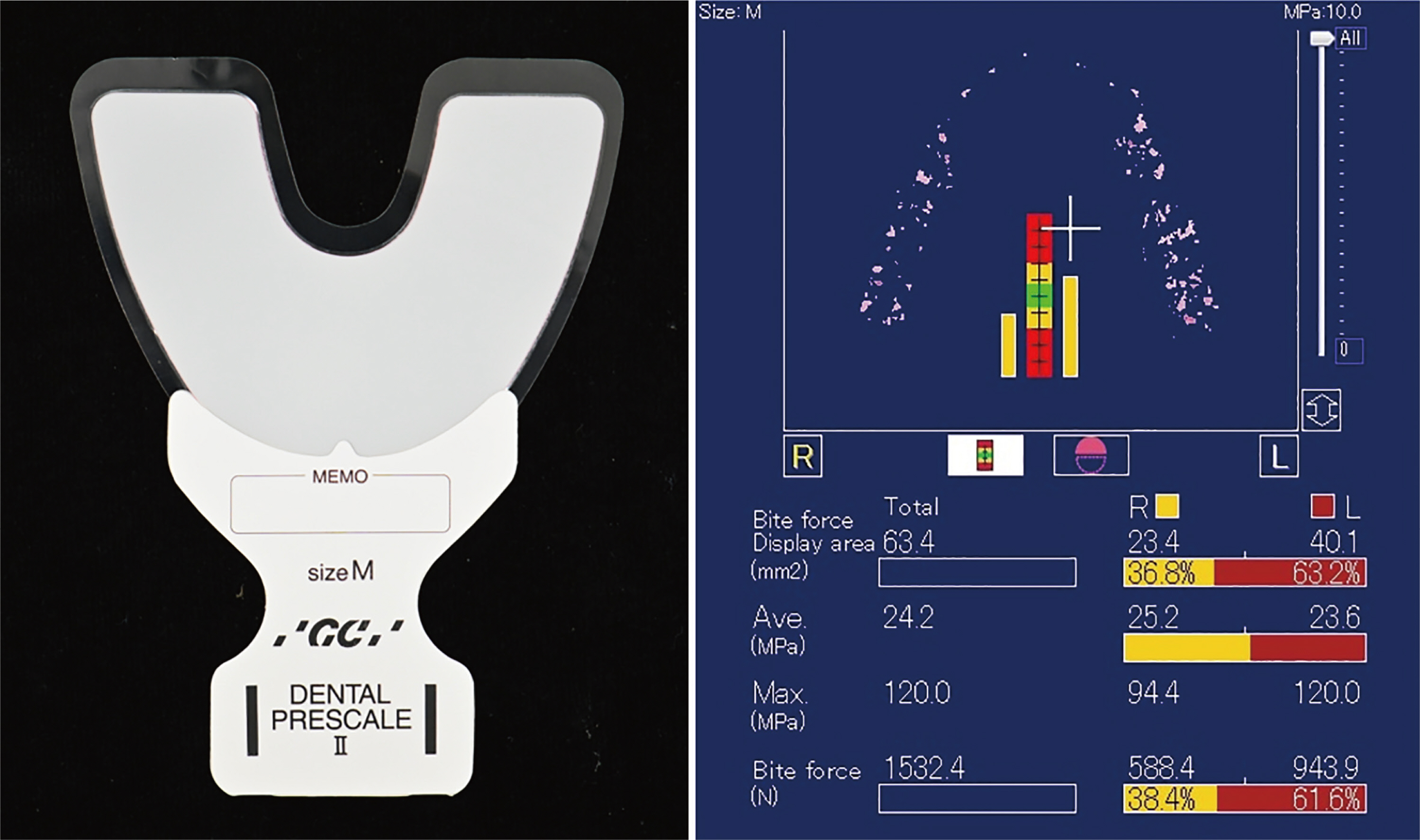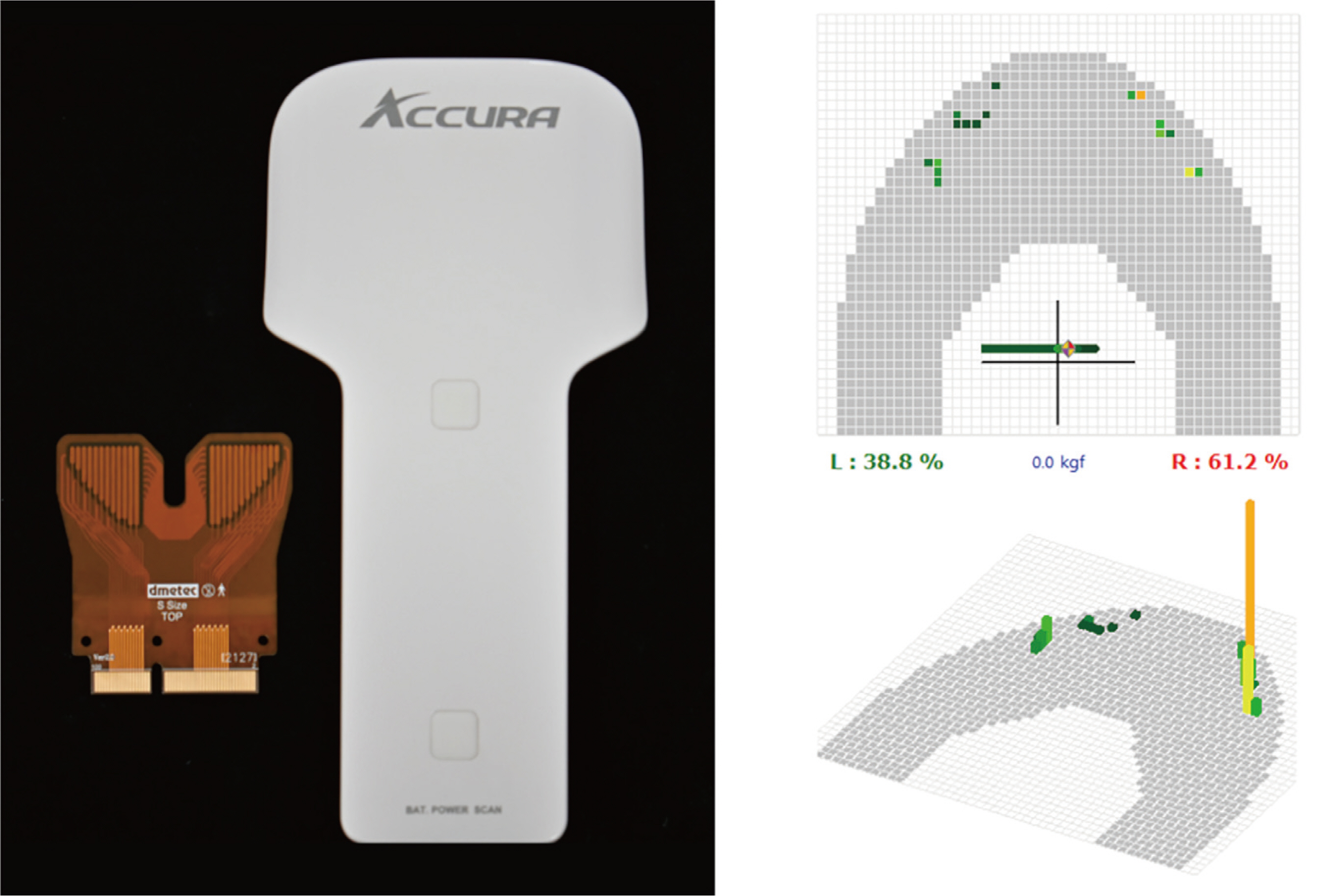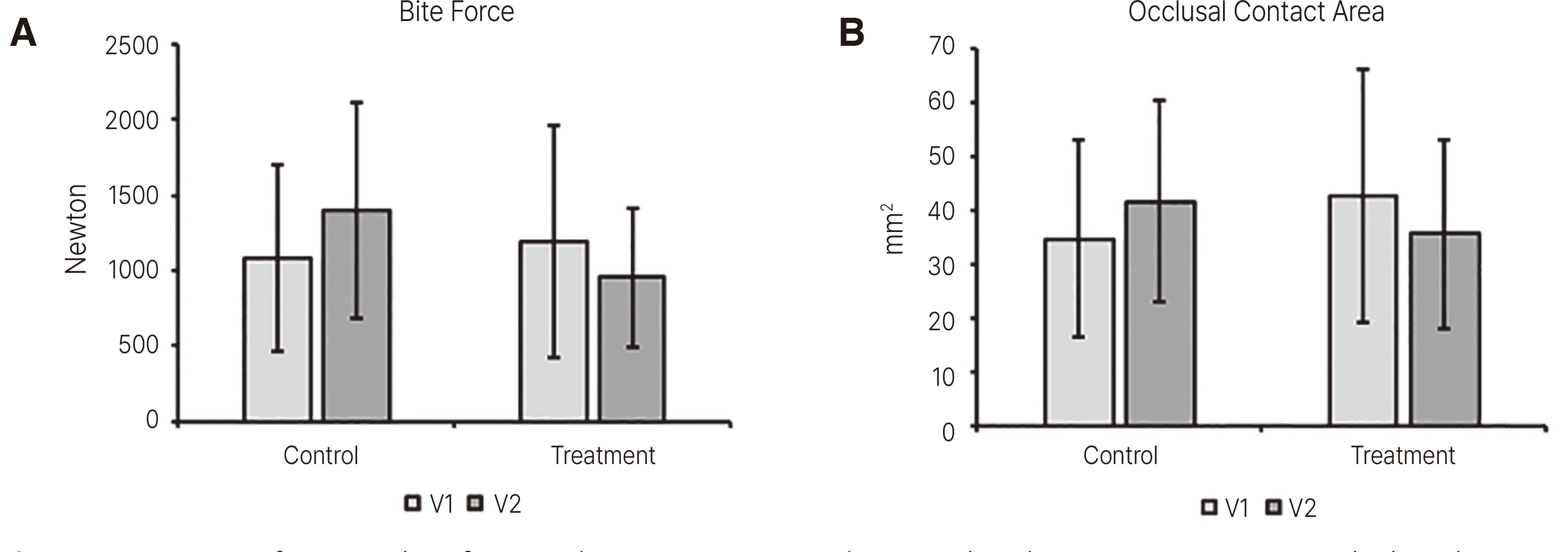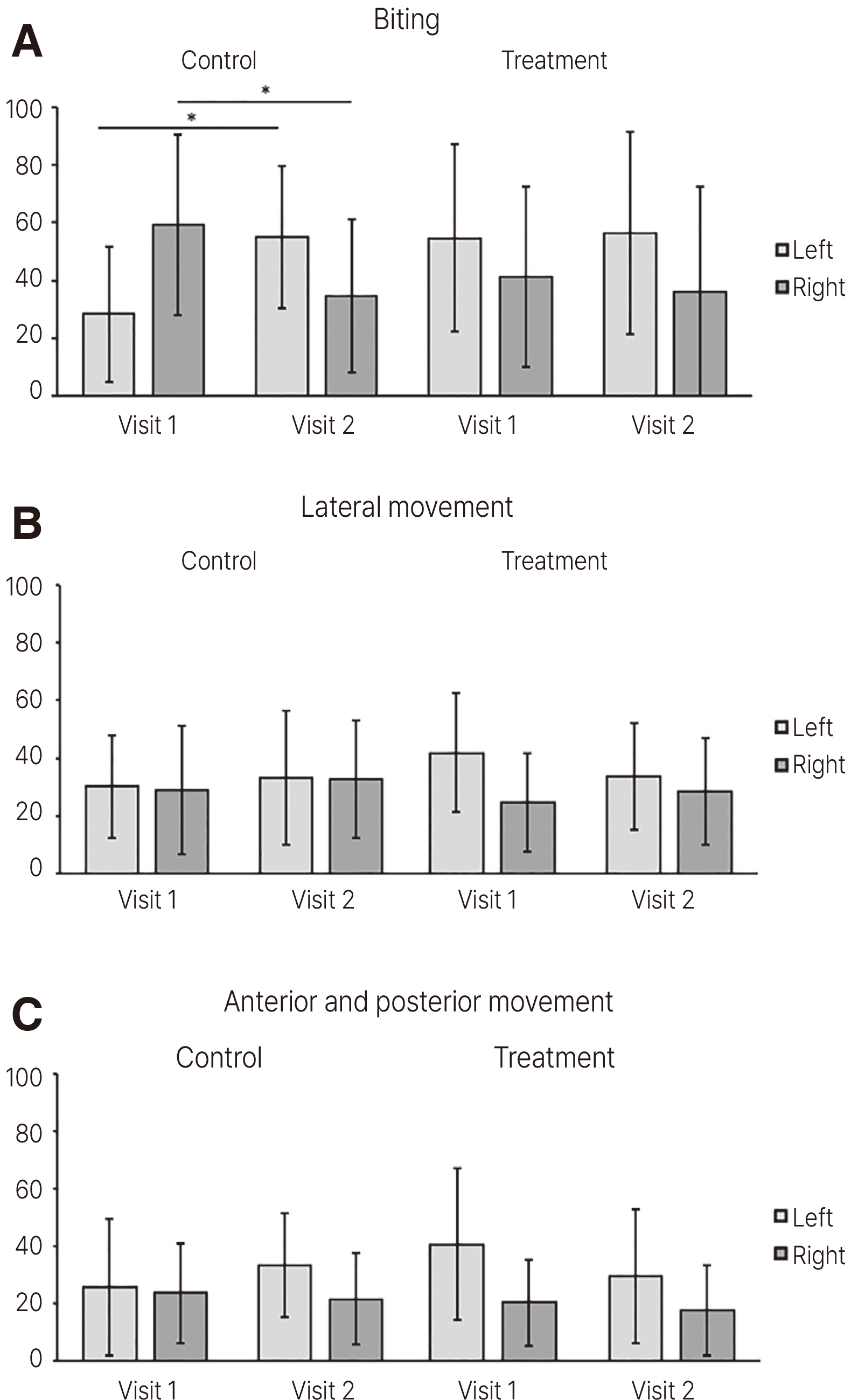J Dent Rehabil Appl Sci.
2022 Dec;38(4):204-212. 10.14368/jdras.2022.38.4.204.
Changes of bite force and dynamic functional occlusion analysis after occlusal stabilization splint therapy in sleep bruxism patients: a pilot study
- Affiliations
-
- 1Department of Advanced General Dentistry, Yonsei University College of Dentistry, Seoul, Republic of Korea
- 2Department of Orofacial Pain and Oral Medicine, Yonsei University College of Dentistry, Seoul, Republic of Korea
- KMID: 2538518
- DOI: http://doi.org/10.14368/jdras.2022.38.4.204
Abstract
- Purpose
The aim of this study was to compare changes of bite force, occlusal contact area, and dynamic functional occlusion analysis after occlusal stabilization splint therapy during sleep for one month in a patient with bruxism.
Materials and Methods
From October 2021 to July 2022, sleep bruxism of 30 patients who visited the Department of Oral Medicine at Yonsei University College of Dentistry Hospital were recruited. The participants were divided into two groups: using an occlusal stabilization splint during sleep (treatment; n = 15) and not using an occlusal stabilization splint (control; n = 15). Before using the occlusal stabilization splint and one month after, bite force, occlusal contact area and dynamic functional occlusion analysis (ratio of left/right bite forces, average bite forces, maximum bite forces, and maximum contact areas during lateral and anterior and posterior mandibular movements) were performed.
Results
There was no difference in bite force and occlusal contact area between the treatment group using the occlusal stabilization splint and the control group not using the occlusal stabilization splint during sleep for one month. However, there were significant differences in the average bite force and maximum bite force in the lateral and anterior and posterior mandibular movements and the maximum contact areas in the anterior and posterior mandibular movements.
Conclusion
The occlusal stabilization splint is helpful for sleep bruxism patients who lateral and anterior and posterior mandibular movements. In addition, further studies are needed a double-blind study with a large population.
Keyword
Figure
Reference
-
References
1. de Baat C, Verhoeff M, Ahlberg J, Manfredini D, Winocur E, Zweers P, Rozema F, Vissink A, Lobbezoo F. 2021; Medications and addictive substances potentially inducing or attenuating sleep bruxism and/or awake bruxism. J Oral Rehabil. 48:343–54. DOI: 10.1111/joor.13061. PMID: 32716523. PMCID: PMC7984358. PMID: https://www.scopus.com/inward/record.uri?partnerID=HzOxMe3b&scp=85089152620&origin=inward.
Article2. Sateia MJ. 2014; International classification of sleep disorders-third edition: highlights and modifications. Chest. 146:1387–94. DOI: 10.1378/chest.14-0970. PMID: 25367475. PMID: https://www.scopus.com/inward/record.uri?partnerID=HzOxMe3b&scp=84910020175&origin=inward.
Article3. Attanasio R. 1991; Nocturnal bruxism and its clinical management. Dent Clin North Am. 35:245–52. DOI: 10.1016/S0011-8532(22)01351-9. PMID: 1997355.
Article4. Lobbezoo F, Van Der Zaag J, Naeije M. 2006; Bruxism: its multiple causes and its effects on dental implants - an updated review. J Oral Rehabil. 33:293–300. DOI: 10.1111/j.1365-2842.2006.01609.x. PMID: 16629884. PMID: https://www.scopus.com/inward/record.uri?partnerID=HzOxMe3b&scp=33645868971&origin=inward.
Article5. Bader G, Lavigne G. 2000; Sleep bruxism; an overview of an oromandibular sleep movement disorder. REVIEW ARTICLE. Sleep Med Rev. 4:27–43. DOI: 10.1053/smrv.1999.0070. PMID: 12531159. PMID: https://www.scopus.com/inward/record.uri?partnerID=HzOxMe3b&scp=0034070165&origin=inward.6. Lavigne GJ, Khoury S, Abe S, Yamaguchi T, Raphael K. 2008; Bruxism physiology and pathology: an overview for clinicians. J Oral Rehabil. 35:476–94. DOI: 10.1111/j.1365-2842.2008.01881.x. PMID: 18557915. PMID: https://www.scopus.com/inward/record.uri?partnerID=HzOxMe3b&scp=44949175964&origin=inward.
Article7. Amemori Y. 1999; Influence of bruxism during sleep on stomatognathic system. Kokubyo Gakkai Zasshi. 66:76–87. DOI: 10.5357/koubyou.66.76. PMID: 10332150. PMID: https://www.scopus.com/inward/record.uri?partnerID=HzOxMe3b&scp=0033088287&origin=inward.
Article8. Sharav Y, Singer E, Schmidt E, Dionne RA, Dubner R. 1987; The analgesic effect of amitriptyline on chronic facial pain. Pain. 31:199–209. DOI: 10.1016/0304-3959(87)90036-4. PMID: 3431880. PMID: https://www.scopus.com/inward/record.uri?partnerID=HzOxMe3b&scp=0023625607&origin=inward.
Article9. Ramfjord SP, Ash MM. 1994; Reflections on the Michigan occlusal splint. J Oral Rehabil. 21:491–500. DOI: 10.1111/j.1365-2842.1994.tb01164.x. PMID: 7996334. PMID: https://www.scopus.com/inward/record.uri?partnerID=HzOxMe3b&scp=0028512355&origin=inward.
Article10. Clark GT, Beemsterboer PL, Solberg WK, Rugh JD. 1979; Nocturnal electromyographic evaluation of myofascial pain dysfunction in patients undergoing occlusal splint therapy. J Am Dent Assoc. 99:607–11. DOI: 10.14219/jada.archive.1979.0348. PMID: 292717. PMID: https://www.scopus.com/inward/record.uri?partnerID=HzOxMe3b&scp=0018527353&origin=inward.
Article11. Pierce CJ, Gale EN. 1988; A comparison of different treatments for nocturnal bruxism. J Dent Res. 67:597–601. DOI: 10.1177/00220345880670031501. PMID: 3170898. PMID: https://www.scopus.com/inward/record.uri?partnerID=HzOxMe3b&scp=0023974924&origin=inward.
Article12. Dubé C, Rompré PH, Manzini C, Guitard F, de Grandmont P, Lavigne GJ. 2004; Quantitative polygraphic controlled study on efficacy and safety of oral splint devices in tooth-grinding subjects. J Dent Res. 83:398–403. DOI: 10.1177/154405910408300509. PMID: 15111632. PMID: https://www.scopus.com/inward/record.uri?partnerID=HzOxMe3b&scp=2442655612&origin=inward.
Article13. Holmgren K, Sheikholeslam A, Riise C. 1993; Effect of a full-arch maxillary occlusal splint on parafunctional activity during sleep in patients with nocturnal bruxism and signs and symptoms of craniomandibular disorders. J Prosthet Dent. 69:293–7. DOI: 10.1016/0022-3913(93)90109-2. PMID: 8445561. PMID: https://www.scopus.com/inward/record.uri?partnerID=HzOxMe3b&scp=0027569752&origin=inward.
Article14. Yap AU. 1998; Effects of stabilization appliances on nocturnal parafunctional activities in patients with and without signs of temporomandibular disorders. J Oral Rehabil. 25:64–8. DOI: 10.1046/j.1365-2842.1998.00194.x. PMID: 9502129. PMID: https://www.scopus.com/inward/record.uri?partnerID=HzOxMe3b&scp=0031606992&origin=inward.
Article15. Ommerborn MA, Schneider C, Giraki M, Schäfer R, Handschel J, Franz M, Raab WHM. 2007; Effects of an occlusal splint compared with cognitive-behavioral treatment on sleep bruxism activity. Eur J Oral Sci. 115:7–14. DOI: 10.1111/j.1600-0722.2007.00417.x. PMID: 17305711. PMID: https://www.scopus.com/inward/record.uri?partnerID=HzOxMe3b&scp=33847001195&origin=inward.
Article16. Mora MCS, Weber D, Neff A, Rief W. 2013; Biofeedback-based cognitive-behavioral treatment compared with occlusal splint for temporomandibular disorder: a randomized controlled trial. Clin J Pain. 29:1057–65. DOI: 10.1097/AJP.0b013e3182850559. PMID: 23446073. PMID: https://www.scopus.com/inward/record.uri?partnerID=HzOxMe3b&scp=84887821463&origin=inward.17. Casas JM, Beemsterboer P, Clark GT. 1982; A comparison of stress-reduction behavioral counseling and contingent nocturnal EMG feedback for the treatment of bruxism. Behav Res Ther. 20:9–15. DOI: 10.1016/0005-7967(82)90003-1. PMID: 7066007. PMID: https://www.scopus.com/inward/record.uri?partnerID=HzOxMe3b&scp=0020294049&origin=inward.
Article18. Turk DC, Zaki HS, Rudy TE. 1993; Effects of intraoral appliance and biofeedback/stress management alone and in combination in treating pain and depression in patients with temporomandibular disorders. J Prosthet Dent. 70:158–64. DOI: 10.1016/0022-3913(93)90012-D. PMID: 8371179. PMID: https://www.scopus.com/inward/record.uri?partnerID=HzOxMe3b&scp=0027651105&origin=inward.
Article19. Carlson CR, Bertrand PM, Ehrlich AD, Maxwell AW, Burton RG. 2001; Physical self-regulation training for the management of temporomandibular disorders. J Orofac Pain. 15:47–55. PMID: 11889647. PMID: https://www.scopus.com/inward/record.uri?partnerID=HzOxMe3b&scp=0035754053&origin=inward.20. van der Zaag J, Lobbezoo F, Wicks DJ, Visscher CM, Hamburger HL, Naeije M. 2005; Controlled assessment of the efficacy of occlusal stabilization splints on sleep bruxism. J Orofac Pain. 19:151–8. DOI: 10.1016/j.ajodo.2005.08.022. PMID: 15895838.
Article21. Dao TT, Lavigne GJ. 1998; Oral splints: the crutches for temporomandibular disorders and bruxism? Crit Rev Oral Biol Med. 9:345–61. DOI: 10.1177/10454411980090030701. PMID: 9715371. PMID: https://www.scopus.com/inward/record.uri?partnerID=HzOxMe3b&scp=2442762462&origin=inward.
Article22. Sheikholeslam A, Holmgren K, Riise C. 1986; A clinical and electromyographic study of the long-term effects of an occlusal splint on the temporal and masseter muscles in patients with functional disorders and nocturnal bruxism. J Oral Rehabil. 13:137–45. DOI: 10.1111/j.1365-2842.1986.tb00646.x. PMID: 3457133. PMID: https://www.scopus.com/inward/record.uri?partnerID=HzOxMe3b&scp=0022651105&origin=inward.
Article23. Lobbezoo F, van der Glas HW, van Kampen FM, Bosman F. 1993; The effect of an occlusal stabilization splint and the mode of visual feedback on the activity balance between jaw-elevator muscles during isometric contraction. J Dent Res. 72:876–82. DOI: 10.1177/00220345930720050801. PMID: 8501285. PMID: https://www.scopus.com/inward/record.uri?partnerID=HzOxMe3b&scp=0027601456&origin=inward.
Article24. Visser A, Naeije M, Hansson TL. 1995; The temporal/masseter co-contraction: an electromyographic and clinical evaluation of short-term stabilization splint therapy in myogenous CMD patients. J Oral Rehabil. 22:387–9. DOI: 10.1111/j.1365-2842.1995.tb00789.x. PMID: 7616350. PMID: https://www.scopus.com/inward/record.uri?partnerID=HzOxMe3b&scp=0029303082&origin=inward.
Article25. Kurita H, Ikeda K, Kurashina K. 2000; Evaluation of the effect of a stabilization splint on occlusal force in patients with masticatory muscle disorders. J Oral Rehabil. 27:79–82. DOI: 10.1046/j.1365-2842.2000.00498.x. PMID: 10632847. PMID: https://www.scopus.com/inward/record.uri?partnerID=HzOxMe3b&scp=0033629011&origin=inward.
Article26. Landulpho AB, e Silva WA, e Silva FA, Vitti M. 2002; The effect of the occlusal splints on the treatment of temporomandibular disorders - a computerized electromyographic study of masseter and anterior temporalis muscles. Electromyogr Clin Neurophysiol. 42:187–91. PMID: 11977433. PMID: https://www.scopus.com/inward/record.uri?partnerID=HzOxMe3b&scp=0036214947&origin=inward.27. Harada T, Ichiki R, Tsukiyama Y, Koyano K. 2006; The effect of oral splint devices on sleep bruxism: a 6-week observation with an ambulatory electromyographic recording device. J Oral Rehabil. 33:482–8. DOI: 10.1111/j.1365-2842.2005.01576.x. PMID: 16774505. PMID: https://www.scopus.com/inward/record.uri?partnerID=HzOxMe3b&scp=33745028621&origin=inward.
Article28. Suzuki T, Kumagai H, Watanabe T, Uchida T, Nagao M. 1997; Evaluation of complete denture occlusal contacts using pressure-sensitive sheets. Int J Prosthodont. 10:386–91. PMID: 9484050. PMID: https://www.scopus.com/inward/record.uri?partnerID=HzOxMe3b&scp=0031173614&origin=inward.29. Maness WL, Benjamin M, Podoloff R, Bobick A, Golden RF. 1987; Computerized occlusal analysis: a new technology. Quintessence Int. 18:287–92. PMID: 3472263. PMID: https://www.scopus.com/inward/record.uri?partnerID=HzOxMe3b&scp=0023316413&origin=inward.
- Full Text Links
- Actions
-
Cited
- CITED
-
- Close
- Share
- Similar articles
-
- Evaluation of the effect of two different occlusal splints on maximum occlusal force in patients with sleep bruxism: a pilot study
- The Effect of Stabilization Splint Use on Bite Force in Patients with Bruxism
- Changes of bite force and occlusal contacts after stabilization splint therapy
- Computerized analysis of occlusal contacts in bruxism patients treated with occlusal splint therapy
- Differences in Psychological Changes after Botulinum Toxin A Administration for Bruxism with Masseter Hypertrophy





